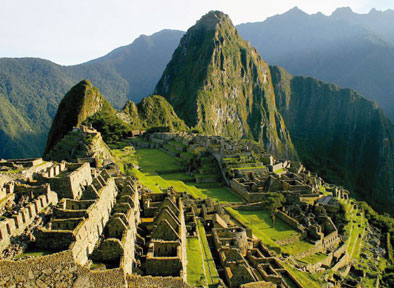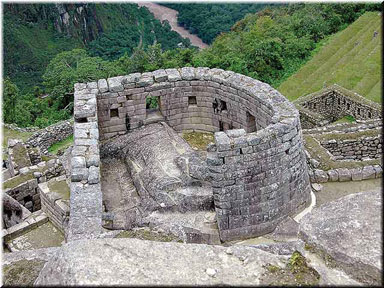Pablo Neruda and 'Las Alturas de Machu Picchu'
 Pablo Neruda was the pen name and, later, legal name of the Chilean
Communist writer and politician Neftalí Ricardo Reyes Basoalto. He chose
his pen name in honour of the famous Czech poet Jan Neruda. Neruda was
accomplished in a variety of styles, ranging from erotically charged
love poems, such as his collection of ' Twenty Poems of Love and a Song
of Despair', surrealist poems, historical epics, and overtly political
manifestos. Pablo Neruda was the pen name and, later, legal name of the Chilean
Communist writer and politician Neftalí Ricardo Reyes Basoalto. He chose
his pen name in honour of the famous Czech poet Jan Neruda. Neruda was
accomplished in a variety of styles, ranging from erotically charged
love poems, such as his collection of ' Twenty Poems of Love and a Song
of Despair', surrealist poems, historical epics, and overtly political
manifestos.
In 1971 Neruda won the Nobel Prize for Literature. Colombian novelist
Gabriel García Márquez once called him "the greatest poet of the 20th
century in any language." Neruda always wrote in green ink as it was the
color of "esperanza" (hope).On July 15, 1945, at Pacaembu Stadium in São
Paulo, Brazil, he read to 100,000 people in honor of Communist
revolutionary leader Luís Carlos Prestes.
During his lifetime, Neruda occupied many diplomatic posts and served
as a senator for the Chilean Communist Party. When Conservative Chilean
President González Videla outlawed communism in Chile in 1948, a warrant
was issued for Neruda's arrest. Friends hid him for months in a house
basement in the Chilean port of Valparaíso.
 |
|
Machu Picchu Terraces
|
Later, Neruda escaped into
exile through a mountain pass near Maihue Lake into Argentina. Years
later, Neruda was a close collaborator to socialist President Salvador
Allende. When Neruda returned to Chile after his Nobel Prize acceptance
speech, Allende invited him to read at the Estadio Nacional before
70,000 people.
Neruda composed his epic twelve-part poem 'Las Alturas de Machu
Picchu' in 1945, two years after visiting the city himself. The Heights
of Machu Picchu is a long narrative poem forming book 2 of Pablo
Neruda's monumental choral epic, 'Canto general' (general song), a text
comprising 250 poems and organized into twelve major divisions, or
cantos. The theme of Canto general is humankind's struggle for justice
in the New World. 'The Heights of Machu Picchu' is itself divided into
twelve sections and it is written in free verse.
Machu Picchu is an ancient Inca fortress city in the Andes Mountains,
south-central Peru. Located near Cuzco in a narrow saddle between two
sharp peaks, at 7,710 ft (2,350 m), it escaped detection by the
Spaniards, and its existence was discovered in 1911 by U.S. explorer
Hiram Bingham. One of the few pre-Columbian urban centres found nearly
intact, it is about 5 sq mi (13 sq km) in area and includes a temple and
a citadel.
Machu Picchu is one of the most important historical monuments in the
world. The Incas built more than 14,000 miles of roads, 600 terraces,
thousands of steps, several temples, 16 fountains (sometimes using up to
20 tons stones). It was probably created around 1450, at the height of
the Inca Empire. Much uncertainty remains as to the real purpose of
Machu Picchu. There is some speculation that it was a prison or a
defensive retreat, yet the most common belief is that Machu Picchu was
the estate of an Inca emperor. It's also generally accepted that it was
a self-sustaining city.
 |
|
Machu Picchu |
The evidence for this the existence of farming
terraces. If building a city high in the mountains, it would have been a
difficult journey to other cities to get supplies. However even the
self-sufficiency of Machu Picchu is debatable. Some believe that the
farming terraces are actually structures to help Machu Picchu withstand
earthquakes.
Probably one of the most significant features of Machu Picchu's
history is its architecture. Like the pyramids of Egypt, it was created
using massive stones hauled over great distances.However, unlike the
Egyptians, the Incas didn't use any kind of mortar to bind their stones
together. Instead they cut the stones with such precision that they fit
together so tightly that even a thin knife blade would not fit between
them.This design made Inca structures highly resistant to earthquakes
and that is one of the reasons Machu Picchu is still standing today.
There has been much speculation with regards to how the Incas could
have made such cut stone to such precise dimensions without the help of
modern technology. Some have even gone as far as to suggest that the
Incas had extraterrestrial help! Yet whatever the true explanation, the
fact remains that the Machu Picchu architecture is the real attraction
of this lost city. It is easy to understand how Neruda was inspired to
write the poem 'The Heights of Machu Picchu'. An excerpt taken from
different parts of this long piece follows. Next week's column will
examine, in sections, the meaning of the most significant parts of the
poem.
The Heights of Machu
Picchu
From air to air, like an empty net,
I went wondering between the streets and the
atmosphere, arriving and saying goodbye,
leaving behind in autumn's advent the coin extended
from the leaves, and between Spring and the what,
that which the greatest love, as within a falling glove,
hands over to us a large moon.
And then on the ladder of the earth I
climbed
through the atrocious thicket of the lost jungles
up to you, Machu Picchu.
High city of scaled stones,
at last a dwelling where the terrestrial
did not hide in its sleeping clothes.
In you, like two parallel lines,
the cradle of the lightning-bolt and man
rocked together in a thorny wind.
Mother of stone, spume of the condors.
High reef of the human dawn.
Shovel lost in the first sand.
This was the dwelling, this is the place:
here the wide kernels of maize rose up
and fell again like red hail.
Here the gold thread was fleeced off the vicuña
to clothe the love affairs, the tombs, the mothers,
the king, the prayers, the warriors.
Here in the high carnivorous lairs the feet of man
rested at night next to the feet of the eagle,
and at dawn
tread with thunderous feet through the rarefied fog,
and touched the soil and the stones
until they could recognize them at night or in death.
I stare at the clothes and the hands,
the trace of water in the echoing hollow,
the wall worn smooth by the touch of a face
that with my eyes stared at the terrestrial lamps,
that with my hands oiled the vanished
timbers: because everything, clothing, skin, jars,
words, wine, bread,
was gone, fallen to the earth.
And the air came in with orange-blossom fingers
over all those asleep:
a thousand years of air, months, weeks of air,
of blue wind, of iron cordillera,
that were like soft hurricanes of footsteps
polishing the lonely boundary of the stone.
Machu Picchu, did you place
stone upon stone, and at the base, rags?
Coal above coal, and at the bottom, the teardrop?
Fire into gold, and within it, trembling, the heavy
red raindrop of blood?
"Give me back the slave that you buried!
Shake the hard bread of the wretched poor
out from the ground, show me the servant's
clothes and his window.
Tell me how he slept when he lived." |

